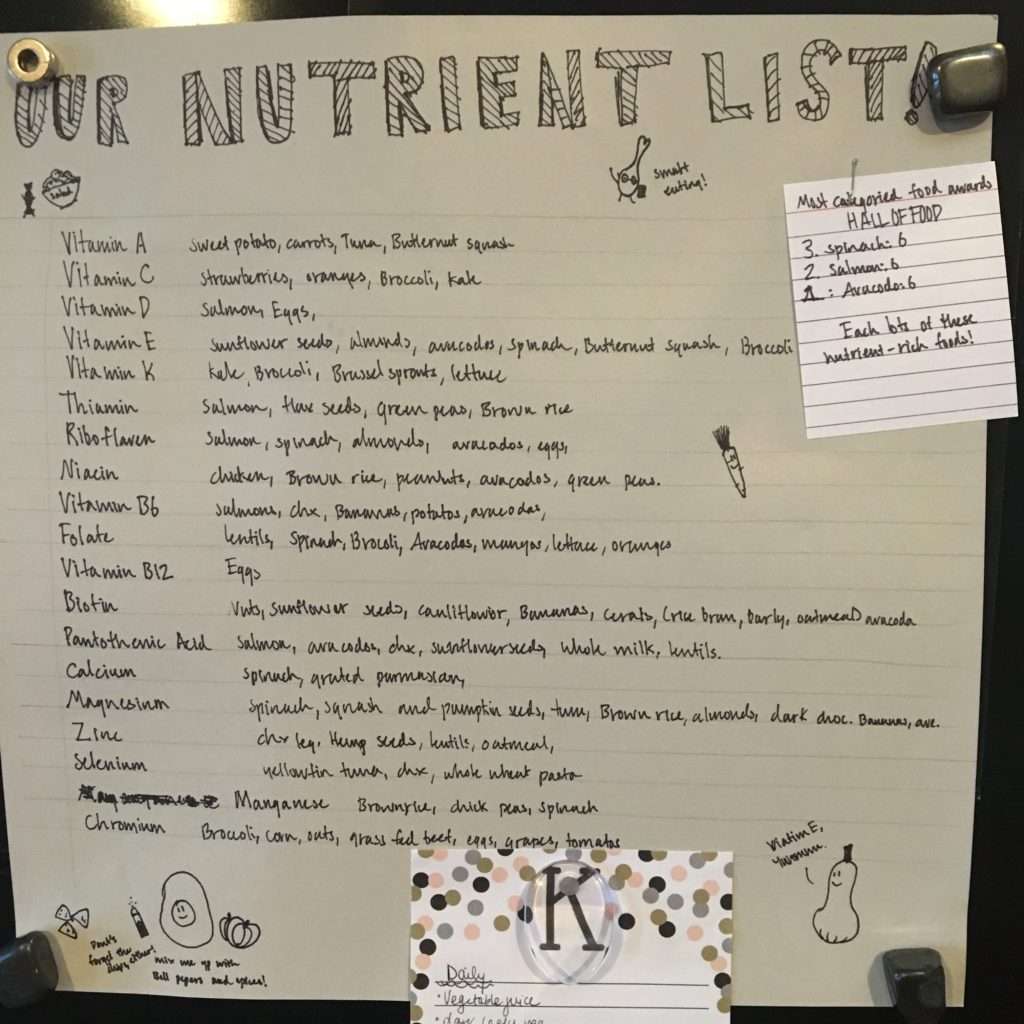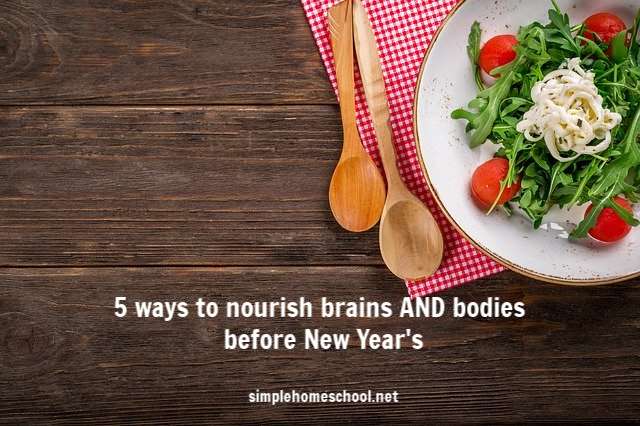Written by Kari Patterson
I know, I know. It’s the holidays. No one wants to talk about nutrition right now. But you know what?
Two weeks from today the shelves that are stocked with candy will be filled with vitamins, so maybe the best time to make a small change is now.
I’ve found that changes are more likely to stick when they are made at odd times (not New Year’s, etc.). Why?
Because when it’s not what everyone else is doing, the change represents something I’m serious about, not just an obligatory resolution.The great thing is, we don’t need new data. We all know that what we eat greatly impacts our cognitive function (especially memory), mood, and ability to focus.
Studies abound linking nutrition and behavior, school performance, and overall well-being. Science is even finding that diseases such as Alzheimer’s are less linked to genetic disposition and more linked to environmental factors such as diet.
So if we know that nutrition matters, why is it so hard to making healthy-eating a priority?
For me, I think the three biggest factors are: Time, picky eaters, and ever-changing diet trends.
Let’s be honest: You spend an hour prepping and cooking homemade lentil soup, only to have your kids make gagging sounds and ask if they can have Easy Mac. Pretty disheartening.
Not only that, it feels like the rules are always changing. There used to be a pyramid and now there’s a circle, and we used to shun fat and now we love fat, and trying to keep up can be exhausting and we’re just trying to put food on the table, people!
We’re already full-time educators and now we have to be chefs as well?

But there’s good news: It really doesn’t have to be that complicated.
There are three things that every diet agrees on:
- Eat real food.
- More plants, less sugar.
- The closer to the food’s natural form, the better.
This will narrow things down quickly! If I can’t pronounce it, chances are it isn’t helping my kids’ brains. Increasing vegetable and decreasing sugar consumption is probably the easiest and most effective way to improve the overall quality of our kids’ diets.
Want some simple ways to put this into practice, even during the holidays?
Here are five things that work well for us:
1. Prep food together
Ya’ll know this: The more involved kids are in prepping a meal the more likely they are to eat it.
I’m not the best in this area, but I see the fruit of this in the lives of close friends who are diligent about including their children in every step of food prep.
It’s amazing to see how capable their kids are and how they eat everything!
Baby step: As part of your daily lessons, do one task of food prep together.
2. Make it easier on yourself
The decision to eat healthy is incredibly difficult when you’re hangry and facing a cupboard full of tempting treats, but it’s much easier to make when you’re full and walking the aisles of the grocery store.
I’ve found that the kids and I will eat whatever is on hand. Sure, I often crave treats and snacks, but the reality is I live 20 minutes from the closest store and have a baby who doesn’t like his carseat.
Make it easier on yourself, and don’t keep it on hand!
Baby step: Leave the store without just one of your usual treats.

3. Include nutritional studies in your homeschool
I recently had my daughter Heidi do a study for me to help us along in this area. She researched the top foods containing key nutrients, and made a sign we posted on our fridge.
She had so much fun making the sign, she asked if she could create a “Hall of Food” featuring those special foods that topped the list of many different nutrients. Without knowing it she had st umbled upon Superfoods all by herself!
umbled upon Superfoods all by herself!
She then suggested that we make a list of snacks that include as many of these nutrient-rich foods as possible.
Umm…yes please!
We were also both very excited about listing “dark chocolate” as a great source of magnesium–we solemnly pledged to partake in some each and every day.
Baby steps: Create an age-appropriate assignment for your kids, educating them about nutrition.
Many kids? Assign a different nutrient to each child, or give them a particularly nutritious food (salmon, spinach, walnuts) and let them discover its wonders!
4. Make it look lovely
The truth is, how something looks goes a long way in making it appealing. The great news is, bright colors are beautiful! Challenge kids to make their plates as colorful as possible.
Make foods that include as many vibrant vegetables as possible. Or be creative with presentation. The kids’ book Honest Pretzels (afflink) has fun ideas for healthy-snacks and look fancy and/or fun.
Baby steps: Aim for two colors at breakfast and three at lunch and dinner.
5. You, Not Them
This aspect of the Leadership Education philosophy translates to nutrition as well! It’s tempting to focus entirely on rehauling our children’s diets, but focusing on ours will yield lasting results in theirs as well.
It’s empowering and freeing to remember that when I choose to nourish my body with healthy, life-giving, nutritious food, I’m reminding myself and my children that my body is worth taking care of.
Their bodies and brains are worth taking care of. Our long-term brain health and cognitive function is worth it.
Pick up a copy of Brain Food, or another easily-accessible book on nutrition and begin your own baby steps.
Come this January 1st, and every January 1st, we’ll be so glad we took these baby steps to feed those precious brains entrusted to our care!
Your turn: What are your favorite tips and tricks for feeding your family nutritiously? I’d love to learn from you!
What’s Your Homeschool Mom Personality? Take Jamie’s quiz now and receive a free personality report to help you organize your homeschool based on what your personality type needs most!



 Weekend homeschool links
Weekend homeschool links
Kari I loved this article! I love working with my kids to hunt down foods they like AND are nutrient dense simple whole foods. It’s seriously like a treasure hunt. It’s so rewarding when they find a dish or ingredient that they like…or even better can cook! We’ve had success with breakfast items with my son (14). He’s had great success with the various ways to make eggs and brown meat, chop & saute veggies for omlets etc. Next we are moving on to soups and meats (things he likes.) Our daughter (11) prefers to focus on desserts or side dishes. We have found that you can make some incredibly nutrient dense desserts using ingredients like peanut or almond butter, sweet potatoes, almond flour, and pure maple syrup. My son and I have sensitive blood sugar, so it has been so rewarding to show them that you can make amazing desserts by swapping nutrient poor ingredients with nutrient dense – low glycemic ingredients. Because hey…everyone needs desserts right!?
Haha, you bet we do! I love this–I agree, it becomes FUN, and my hope is that they see the value and actually enjoy fueling their bodies nutritiously. Thanks for this encouragement, Michele! Happy holidays!
Great post Kari! I agree wholeheartedly that what we eat influences so many aspects of our lives. It’s such an important part of self-care for moms, and setting that good example has certainly influenced my children in positive ways. I think they’ve learned there can/should be a healthy balance in what we eat. I like your idea of incorporating more nutrition studies into homeschool life!
Jamilyn’s latest post: Gratitude Isn’t Just for November